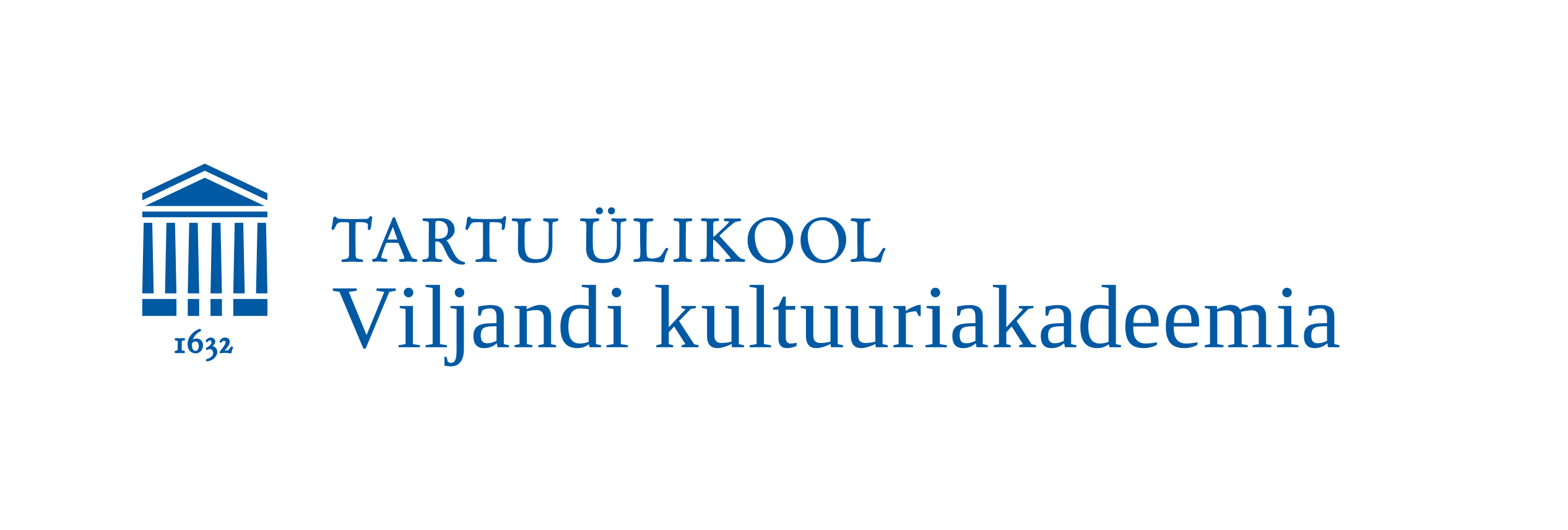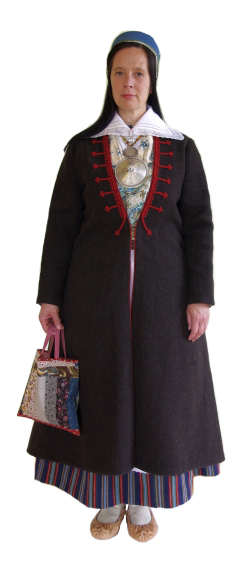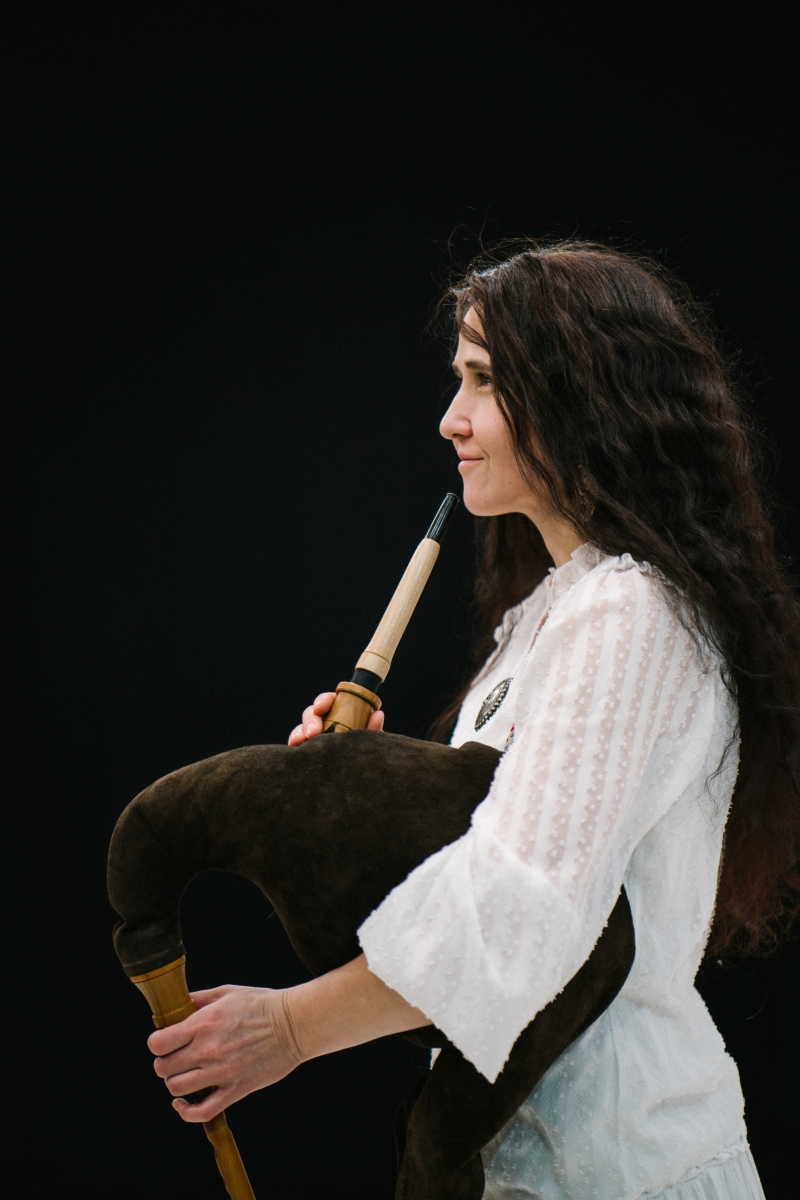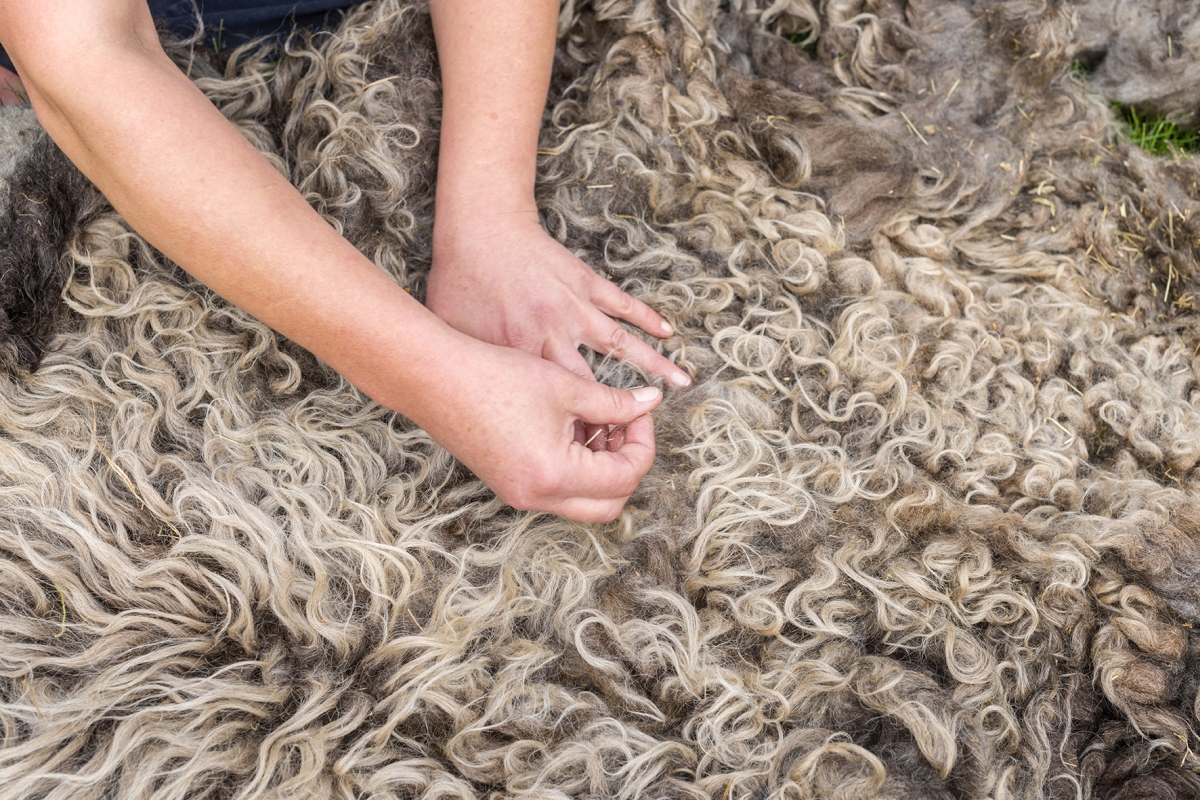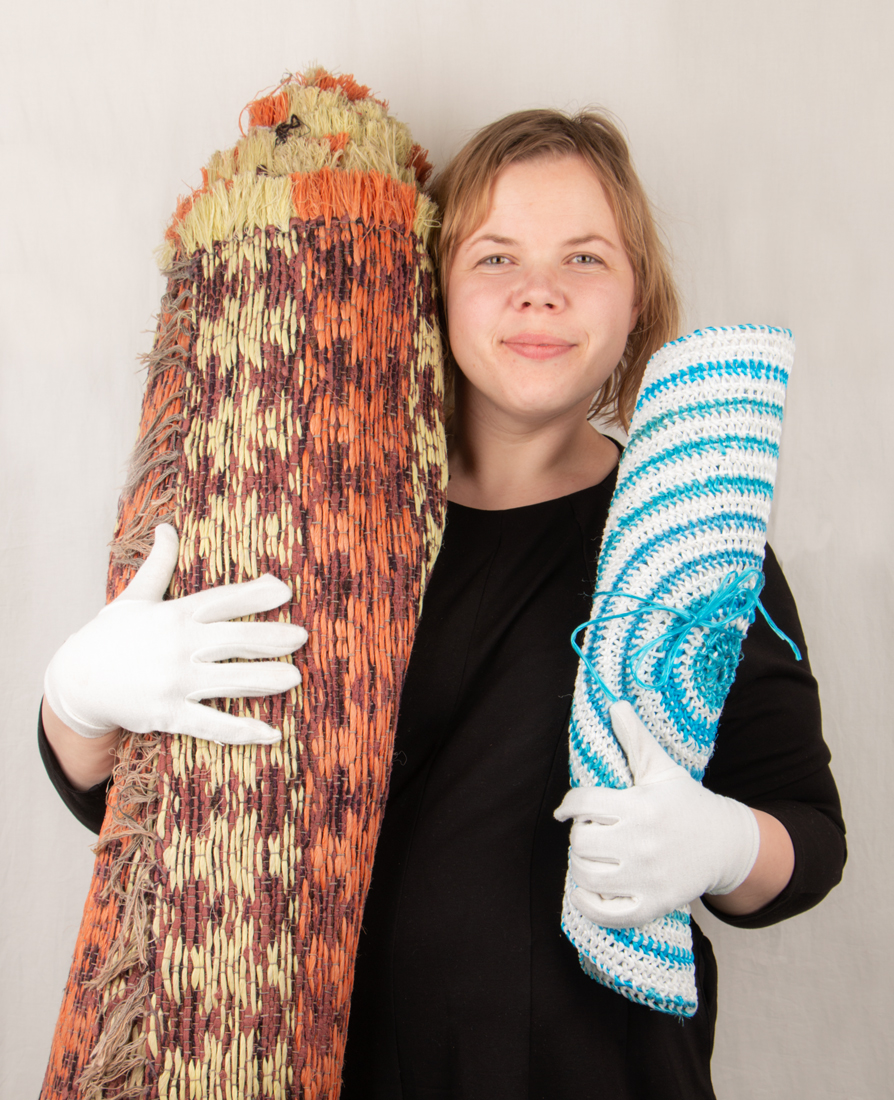“VÄNDRA KIHELKONNA NAISTE TRADITSIOONILISED RAHVARÕIVAD: KOMPLEKTIDE KOOSTAMINE JA VALMISTAMINE TÄNAPÄEVAL” (juhendajad Igor Tõnurist, MA; Kristi Jõeste, MA).
LÜHIÜLEVAADE: Magistritöö “Vändra kihelkonna naiste traditsioonilised rahvarõivad: komplektide koostamine ja valmistamine tänapäeval” on olnud ajendatud üldisest eesmärgist esitleda ühe väikese piirkonna sisest rahvarõivaalast variatiivsuse võimalikkust, et vabaneda rahvarõiva käsitlemisest kui “mundrist”.
Lähtuvalt eesmärkidest, on kõneall olevas uurimustöös teostatud Vändra kihelkonna naiste rahvarõivaste üksikosade kirjeldamine ning ajas tehnoloogiliste ja lõikeliste arengute fikseerimine, materjali- ja värvikasutuse jälgimine, samuti rõivastuse kandmisviisides avalduvate muutuste uurimine. Kirjeldavale tasandile järgnenud rahvarõivakomplekti koostamise põhikriteeriumiks on olnud perioodipõhine jaotus, mille taustal on uuritud eraldi ka kandja staatusest ja kandmise olukorrast (igapäevased, pidulikud, suve- ja talverõivad) lähtuvat ainest, samuti on käsitletud kihelkonnasiseselt ehk siis valla tasandil rahvarõivakomplekti variantide koostamisvõimalusi tänapäeval.
Esemete kirjeldamise käigus tehtud joonised on osa magistritöö praktilisest osast ning üheks eelduseks Vändra naise rahvarõivakomplekti kuuluvate osade tegemisele. Rahvarõivaste valmistamine on tervikuna lai valdkond, mis hõlmab lisaks materjalide tundmisele ka kümne erineva tehnika tundmist. Valminud on 59 rahvarõivakomplekti kuuluvat eset, mida kombineerides ja järgides perioodidesse sobivust, on magistritöös esitletud üheksat erinevat Vändra naise rahvarõivakomplekti. Saadud valmistamiskogemuse põhjal on kajastatud rahvarõivaste originaalilähedase tulemuse taotlemisest lähtuvalt nende valmistamisvõimalusi ja -probleeme tänapäeval.
Uurimuse avalikustamise ajel võib loota, et osatakse mõista rahvarõivastega toimunud muutusi ajas, kogu kostüümi terviklikkuse tähtsust ja vältida vastuolusid edaspidistes valikutes. Rahvarõivakomplektide koostamise kogemus võib olla abiks kõigile Eesti väikepiirkondadele nii esemete paljususes valikute tegemisel kui nende puudumisel lahenduste otsimisel.
Inna Raud
Magistritöö autor
TÜ Viljandi Kultuuriakadeemia
LÄBITUD ÕPPEKAVA: pärandtehnoloogia magistriõppekava.
[Best_Wordpress_Gallery id=”21″ gal_title=”Inna Raud”]
SUMMARY: The Traditional Folk Costumes of the Women of Vändra Parish: Completing and Making Folk Costumes at the Beginning of the 21st Century
This research has been motivated by the scantity of information about the folk costumes of the women of Vändra parish. Currently, in this area, two variations of skirt are known, worn either with a woollen wrap or with a jacket as outerwear, and with a cap on a cardboard construction covered with matching fabric, or with a coif (a cloth cap) as headgear. Investigation of the possible variability of folk costumes in Vändra parish has been based both on literary sources reflecting the field of research as well as on the existing objects (185) available in four of Estonia’s museums and private collections, on photos (6) and manuscript sources (3).
As to its structure, this Master’s thesis differs to some extent from the usual because in addition to the written research it also comprises a practical section. In accordance with the aims of the paper, a description of the items of the folk costumes of the women of Vändra parish has been given in the written part, as well as a study of the changes in technology, sewing patterns, materials, and colours, and the ways of wearing the garments that have taken place over time. The descriptive level has been followed by completing a wholesome folk costume, the basic criterion of which has been a period-based categorization, in connection with which the opportunities of completing a wholesome folk costume nowadays within a parish, on a township level, in accordance with status and situation (everyday, festive, summer, and winter garments) have been studied.
In order to complete a wholesome folk costume of a woman of Vändra parish, it has been possible to choose between 10 ornamental patterns for skirts, 3 belt bags, 43 figured belts, 3 163 chaplets, 3 floral coifs, 60 caps on a cardboard construction, 2 ornamental patterns suitable for woollen wraps, 2 stocking patterns, 8 mitten patterns, and 3 garter patterns. Among finery items (39) there are flat brooches, penannular brooches, pendant coins – both with and without beads – , rings, and a conical brooch. The folk costume as a set of garments entirely lacks some examples of objects from Vändra, such as the apron, the jacket and the bodice as outerwear (in the meaning of clothing designed to be worn outside other garments – opposed to underwear), and the longcoat, the robe (the smock-rock), and the fur coat as outerwear (in the meaning of clothing worn outdoors), and bags, as to accessories. To solve this problem, it has been suggested to choose replacements from neighbouring parishes, first and foremost, taking into account the characteristic features of the folk costumes worn in Pärnu region. To expand the range of option, also the shirts and the women’s dickies from neighbouring parishes have been chosen as examples because only one Vändra shirt and only one Vändra women’s dicky have survived as examples from the late period (the beginning of the 20th century).
On the basis of studies on folk costumes originating from Pärnu region, certain details become significant in one or another parish – in case of Vändra parish, it is the women’s headgear. In Pärnu region, chaplets have traditionally been worn only by Vändra girls, and the so-called Vändra caps constructed on a cardboard frame have been considered a special phenomenon in the typology of headgear worn with the national costumes of Estonia. Besides the headgear, also the skirts stand out because of their pattern (the only exception being the Tori skirt with its red and black stripes) and the fact that neither coloured ribbons nor strips of fabric were used in order to embellish the skirt hems, thus creating the basis of drawing parochial distinction when worn together with the examples of objects chosen from the neighbouring parishes. Luckily, the numerousness of Vändra caps and the commentaries in written sources have helped to bring out the differences within Vändra parish in case of the sewing patterns of caps and the ways of tying the laces of the heelless peasant-shoes called pastlad.
The four periods (see Methodology) have been formed according to the dating of the objects, or else, previous studies on folk costumes have shown the slowly developed harmony of every single item with a certain period. In the course of time, changes have occurred and new items brought into use, married women’s festive headgear having adopted the floral coif, the cap on a cardboard construction, and the bow-shaped lace embellishment called oub, outerwear having introduced the jacket and the bodice, and the woollen wrap to wear on one’s shoulders. The gradually rising neckline of the jacket called kampsun may have called forth the new type of jacket called jakk that was buttoned up to the neck. As to the shirts, the changes have influenced first and foremost the collar – from a narrow welt to a folded collar and then back to a small upright collar. In case of the jackets, puffy sleeves may denote a later period. As to the techniques, crocheting and aniline colours came into use during the second half of the 19th century. As to the materials, the earliest evidence of using cotton fabric for making folk costumes of Vändra parish dates back to 1850.
In case of period-based completing of whole folk costumes, datings proved to be quite complicated to follow, as changes that have occurred in time may have been lengthy processes, thus being difficult to determine very exactly. Today, the widest range of combinations may be achieved by using a plain-coloured skirt which, besides marrying well with items of headgear from different periods, may belong to the everyday costume. As to outerwear, a longcoat enables to wear skirts and headgear from different periods. As to the four periods, completing everyday folk costumes may be divided into three parts – the garments worn throughout the traditional period (the basic items being the simple-sleeved shirt, the plain skirt, the figured belt, the apron, the robe), the 2nd half of the 19th century (the two-coloured skirts), and maybe also the beginning of the 20th century because of the calico jackets that came into use at that time. In reality, it is difficult to draw a distinction between everyday and festive garments, as well as between summer and winter clothes, because the kerchief and the robe may have been worn together with festive garments (in order to protect them), and the fur coat could have been worn in the summer, too.
The diagrams made in the process of describing the objects belong to the practical section of the Master’s thesis and are a prerequisite for crafting different parts of a Vändra woman’s folk costume. Making folk costumes is a sophisticated domain that comprises different techniques (knitting, fabric weaving, figured belt weaving; several plaiting and embroidery techniques, bobbin lace, crocheting, and sewing techniques; designing sewing patterns) needed for crafting folk costumes of Vändra region.
As a part of the practical section of this Master’s thesis, 59 items belonging to a wholesome folk costume have been made either by the author herself or by means of supervising the crafting process (in case of fabric weaving, some items have been commissioned). These items have been combined with each other, and in accordance with the periods, ten different wholesome folk costumes of a Vändra woman have been presented (see Appendix 24).
Today, while trying to copy the folk costumes as closely to the original ones as possible, it has been important to acknowledge the process as a whole – besides the skills, also the availability of different materials both in the 19th and the early 20th centuries, as well as nowadays, had to be taken into account. When doing so, the materials turned out to be the biggest problem – problems with the hues of flaxen yarn and store-bought fabric, as well as with purchasing silken ribbons and the metal thread necessary for making the special lace called kardpits, so that synthetic materials had to be used on coifs, chaplets and caps. Sample items have been made both from hand woven and store-bought fabrics. Whenever possible, the sewing patterns were arranged on the fabric in the same way as they had been laid out in case of the original items; this could be detected by studying the selvedge. Today, in most cases the items have had to be adapted in accordance with the size of the person who is going to wear them, preserving the general impression of the sewing patterns of the original garment. As a result of experiencing the process, the necessity for a more spacious neckline could be pointed out. In the author’s opinion, the sewing patterns of the Vändra cap have not yet achieved perfect results. Reconstruction has been carried out on the ornamental pattern of the floral coif, as well as on a knitted stocking’s cast-on and techniques of shaping the heel and the toe (with a fragment of a stocking as an example).
Bearing in mind the possible supervising activities in the future and leaning on the gained experience, the practical section of the Master’s thesis comprises six projects – instructions on how to make a shirt, a skirt, a longcoat and a jacket, a coif, a cap on a cardboard construction, and heelless peasant-shoes (pastlad). The present paper on Vändra folk costumes enables an interested person to acknowledge the variation opportunities when completing a wholesome folk costume and to carry them out either personally or to act purposefully in order to commission the items. The costumes completed of these newly made items are going to be used as illustrative material for a book planned to give an overview of the folk costumes of Vändra parish. As the garments have been handed over to the Farm Museum of C. R. Jakobson, it is possible to have a closer look at them in the nearest future.
